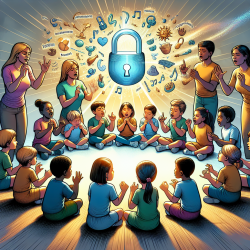As a passionate advocate for data-driven decisions in speech-language pathology, I am thrilled to share insights from a groundbreaking study titled Effects of ASL Rhyme and Rhythm on Deaf Children’s Engagement Behavior and Accuracy in Recitation: Evidence from a Single Case Design. This research offers valuable findings that can help practitioners enhance their approaches and create positive outcomes for deaf children.
In this single-subject study, researchers Holcomb and Wolbers investigated the impact of ASL rhyme and rhythm on the engagement and recitation accuracy of five deaf children aged three to six in an ASL/English bilingual early childhood classroom. The study utilized an alternating treatment design with initial baseline and included four phases: baseline, handshape rhyme awareness intervention, alternating treatments, and preference.
Here are the key takeaways and practical implications for practitioners:
1. Importance of Handshape Rhyme Awareness
The study revealed that explicit instruction in handshape rhyme awareness significantly improved the children’s engagement and recitation accuracy. Practitioners should consider incorporating handshape rhyme awareness activities into their sessions. This can involve:
- Teaching children to recognize and categorize handshapes.
- Using visual aids and interactive games to reinforce handshape patterns.
- Encouraging children to create their own rhyming ASL stories.
2. Engagement Through Imitation
Deaf children in the study showed increased imitation behaviors when exposed to ASL rhyme and rhythm. This aligns with research on hearing children, where imitation is a critical component of language development. To foster engagement, practitioners can:
- Incorporate rhyming ASL stories and songs into therapy sessions.
- Model imitation behaviors and encourage children to sign along.
- Use repetition and rhythm to capture children’s attention and interest.
3. Enhancing Recitation Skills
The study found that children performed better in recitation tasks when exposed to rhyming ASL stories compared to non-rhyming ones. To improve recitation skills, practitioners can:
- Use rhyming ASL stories as a tool for memory and sequencing practice.
- Provide opportunities for children to recite stories from memory, focusing on correct handshape and sequence.
- Incorporate phonological awareness activities to support recitation accuracy.
4. Addressing Language Delays
The study highlighted the challenges faced by children with language delays. Practitioners should be aware of the potential impact of language deprivation and consider interventions that focus on phonological processing tasks. This can include:
- Early and consistent exposure to ASL rhyme and rhythm.
- Targeted interventions to build foundational language skills.
- Collaborating with families to ensure a language-rich environment at home.
In conclusion, the findings from this study underscore the importance of incorporating ASL rhyme and rhythm into therapy sessions for deaf children. By doing so, practitioners can enhance engagement, improve recitation skills, and address language delays, ultimately fostering better language and literacy outcomes.
To read the original research paper, please follow this link: Effects of ASL Rhyme and Rhythm on Deaf Children’s Engagement Behavior and Accuracy in Recitation: Evidence from a Single Case Design.










